Granada, Spain lies at the foot of the frosted Sierra Nevada Mountains in Andalucía, which is a picturesque region with sprawling hillsides and miles of olive groves. Throughout its history, Granada has been a strategic city for its location near the Mediterranean Sea and its ample sources of running water- the rivers Beiro, Darro, and Genil. Here are the top things to do in Granada, Spain!

By the end of the 5th century BC, Granada was a colony of the Greek kingdom and then became part of the ancient Roman Empire among with hundreds of other cities in the Iberian Peninsula. These were known to the Romans as Hispania.
After the Umayyad Moors conquered Hispania in 713, Granada flourished under their rule for the subsequent 700 years until the city surrendered in 1492 during the Reconquista fueled by the Catholic monarchs Ferdinand II of Aragon and Isabella I of Castile.

This surrender was one of the most significant events in the city’s history and unfortunately resulted in the destruction of most of the mosques the Moors had built. In the same year that Granada was won by the Catholic Monarchs, Queen Isabella I commissioned Christopher Columbus’ explorative voyage to the New World.

Granada is best known for its extraordinary Moorish fortress and palace- the Alhambra. Granada’s old city, Albayzin, is also a testament to hundreds of years of Moorish occupation and boasts typical Arab narrow cobblestone streets. The Alhambra and its gardens were declared a UNESCO World Heritage site in 1984, and has remained an iconic and popular tourist site in Spain.

Granada is a city rich with history, culture, and architecture. Tourists from all over the world come to Granada to enjoy its main treasure the Alhambra. Granada’s location allows for breath-taking views of the Sierra Nevada and easy commutes to both skiing and Mediterranean beaches.
It is an ideal place for both romantic and family get-a-ways. Granada is a charming gem in Andalucía, and although its days can be quite hot, the nights are cool and serene. It is no wonder why this city was lusted after and fought for by so many realms. Here are the top 13 things to do in Granada, Spain!

Alhambra literally translates into “the red one” in Arabic. The Alhambra monument is an outstanding example of Moorish design. It sits on a plateau overlooking Granada’s old city and spans approximately 1,530,000 square feet. Construction began on the Alhambra in 1237 with Muhammad Al-Ahmar I, the founder of the Nasrid Dynasty. Work continued and additions made with the seventh heir to the Nasrid throne, Yusuf I. Muhammed Boabdil XIII, the last Muslim Sultan to rule Granada before the Reconquista, surrendered Alhambra to the Catholic Monarchs on January 2nd 1492. Each Muslim ruler continued the “paradise on Earth” theme that can still be seen today.

For the next 24 years after the surrender, the Alhambra monument was restored and altered by the Spanish Royal Family. The Palaces were used by local government officials for meetings and as headquarters for Spanish authorities in the area. Alhambra’s colorful history comes at no surprise once you step onto its lush landscaped grounds. There are four sections of the Alhambra- Alcazaba, Nasrid Palaces, Partal, and Generalife (pronounced Hen-er-al-eef-eh.)

I recommend that you enter the Alhambra at the official entrance pavilion/ ticket office and make your way through Generalife, El Partal, Alcazaba, and leave the Nasrid Palaces for last. This way, you will experience the best for last. Each of the Nasrid Palaces (Mexuar, Comares, and Los Leones) was built by a different Arab ruler of the Nasrid Dynasty as testament to each one’s authority and affluence.

Architect Leopoldo Torres Balbas designed the Generalife Palace and gardens in the 1920’s and 30’s as a place to where the Royal family could escape from their official duties. The Generalife landscape is spectacularly lush and perfectly manicured. Guests will find paths lined with blossoming roses and English Elm trees brought by the Duke of Wellington in 1812. The Darro River feeds the charming cascades and fountains in Generalife.

The Partal is an area containing the palace that Yusuf III built and used to reside. Unfortunately the Spanish monarchy let much of the Partal fall into disrepair and so many of the houses that were once standing did not survive. Alcazaba is one of the oldest sections of Alhambra and was utilized as a military citadel and lookout point. Visitors can stroll the excavated rooms where soldiers slept and where the Arabs stored ammunition. Alcazaba tower is worth the hike up the steps for the brilliant view of the entire city of Granada as well as the Sierra Nevada Mountains.

Finally you will arrive at the Nasrid Palaces, which are most definitely the icing on the cake. Intricate geometric wooden inlays, decorative Arabic inscriptions, and millions of the tiniest, yet delicate, architectural details adorn the Palace walls from top to bottom. The unique carvings in each of the rooms are masterful and truly one of the world’s man-made wonders. The Alhambra monument has inspired architecture, photography, and design for centuries. It is impossible not to leave the Nasrid Palaces without being amazed at their beauty.

It takes approximately 3-4 hours to see all four main areas of the Alhambra, but many visitors opt to see Alhambra in 2 separate visits. It is recommended to rest a short while after visiting Generalife and after seeing the Nasrid Palaces, as these are the largest sections of the monument.

The Alhambra’s visiting hours are as follows: March 15th – October 14th Monday through Sunday 8:30am to 8:00pm, and October 15th – March 14th Monday through Sunday 8:30am to 6:00pm. I recommend purchasing tickets beforehand online directly from the official website. You must purchase a ticket to see the Nasrid Palaces separately from your ticket to see the rest of the monument. The Nasrid Palace ticket will specify a time to enter. Make sure you are there 5-10 minutes before the specified time to be let in.

Tickets sell fast and so purchasing them ahead of time will save you about an hour’s wait outside the ticket office. Also, there will be no guarantee you will be able to purchase a ticket the same day that you arrive unless you book beforehand. Children 12 years and under and/ or who are handicapped enter free. Be sure to wear comfortable shoes, bring sunscreen, and arrive early. You can catch Bus # 30 or # 32 next to Plaza de Isabel la Católica and be there as the doors open at 8:30am to avoid the afternoon crowds.
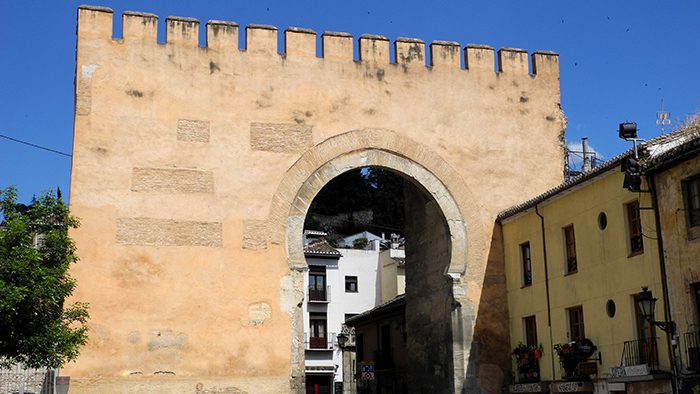
Puerta Elvira (Arch of Elvira) is an 11th century gateway into the Albayzin- Granada’s old city. It is one of the surviving sections of a defensive structure that once surrounded the city. The arch provided a Northern entry point into Granada and was used as a Triumphal route by every ruler that took it. Muhammad Al-Ahmar I marched through Puerta Elvira in 1238 and established the Nasrid Dynasty. The Catholic Monarchs King Ferdinand and Queen Isabella also utilized Puerta Elvira to enter their beloved city on each of their visits.

Later Napoleon’s troops invaded Granada through this ancient gate. Visitors were let in through massive wooden doors that could be lowered, but they have since been removed and just the exterior face remains. Puerta Elvira stands proudly in the Plaza del Triunfo on Calle Elvira.

The Royal Chapel or Capilla Real is a Gothic-style mausoleum and chapel that was commissioned by the Catholic Monarchs in 1504 to serve as their final resting place. The funerary temple has a deep meaning to both the Spanish and other European and American visitors because Spain was linked to Portugal, England, and Austria through the marriage of their children. Also, it was Queen Isabella who enabled Christopher Columbus’ voyage to America and the spread of Spanish culture through the New World. The Royal Chapel contains relics, tapestries, sculptures, and paintings from the 15th century.
Check out Things to See in Caceres, Spain

In recent years the Vatican has donated various religious artifacts that once belonged to the Catholic Monarchs to the city of Granada, and these are currently on display in the Royal Chapel museum. A few steps beneath the Transept section of the Chapel, visitors can see the crypt that contains the coffins of Ferdinand, Isabella, Phillip, Joanna, and the of the young Prince Michael- King Ferdinand’s grandson and heir to the Spanish throne who died in 1500 in Granada at the age of two. In order to preserve the centuries-old art work guests are not allowed to use flash photography inside.

The Cathedral of Granada is a massive structure that was erected on the site where the Nasrid’s main Mosque once stood. It was intended to be a grand symbol of Christianity’s presence in Andalucía. The Cathedral took over 180 years to complete (construction halted during the Plague years) with the help of five architects who added their personal touches throughout the interior and exterior of the building. This is the reason for the Cathedral’s eclectic design features, which include Renaissance, Baroque, Gothic, and Neoclassic elements. The Cathedral was originally intended to be the final resting place of Charles I of Spain, but Phillip II changed his mind and now Charles I and subsequent royals are laid to rest in El Escorial just outside of Madrid.

Once inside, visitors can walk along the perimeter to view the 13 distinct chapels dedicated to various Saints, as well as admire the colossal white marble pillars that encircle the Cathedral’s main altar. Be sure to pay attention when looking up at the Chapel of the Trinity, as you will find paintings by El Greco. Admission costs 3.50 Euros per adult and visiting hours are as follows: March through August: Monday- Saturday 10:45 am- 1:30pm & 4:00pm – 8:00pm and Sundays from 4:00pm- 8:00pm. September through February: Monday- Saturday 10:45 am- 1:30pm & 4:00pm- 7:00pm and Sundays 4:00pm- 7:00pm.
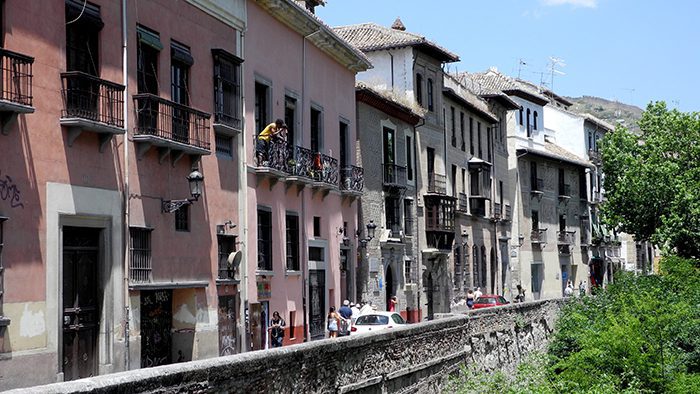
By taking the Alhambra “minibus” # 35 from Plaza Nueva, you can spend some time in the Albayzin, which is a labyrinth of narrow cobbled streets that once comprised the old Arab quarters of city. This is the oldest section of Granada and was declared a UNESCO World Heritage Site in 1984. The streets in the Albayzin offer great views of the Alhambra monument and contain numerous restaurants and shops. You will notice that unlike the lower section of Granada, the square plazas of the Albayzin are smaller in size.

You will also pass in front of various Carmens, or typical Andalucían houses with attached gardens. Owning property in this area of Granada can get pricey and those who live here cherish the history and culture of their neighborhood. Most of the streets in the Albayzin are pedestrian-only, which makes it easy to navigate on foot. Be aware, however, that the Albayzin is located on a hillside and there are many steps to climb for the best views of the Alhambra. On the bright side, coming back down is a breeze.

If you want to make your friends jealous, muster up your energy and make your way up the hill through the Albayzin to the Mirador de San Nicolas (if you are the energetic type you can make the 45 minute climb up the stairs, but if you are not feeling up to it, you can catch minibus # 35 to the hill top.) The Mirador is located in the Plaza de San Nicolas next to the whitewashed Church of San Nicolas high above the Darro River. It boasts the most awe-inspiring views of the Alhambra and the Sierra Nevada.
Check out What to See and Eat in Ourense, Spain

A picture here around sunset will complete your photo album of Granada. Once in the shade of the trees at the Mirador, relax and take in the view. Usually, there are local musicians playing guitars in the Plaza, which keeps the atmosphere lively. There are plenty of restaurants in the area, most of which offer the same incredible view as the Mirador. I recommend you visit in the late afternoon hours to avoid getting sunburned, and so you can catch the sun setting on the Alhambra.

Like with Mirador de San Nicolas, Mirador San Cristobal boasts beautiful panoramic views of Granada, a partial view of the Alhambra monument, the Sierra Nevada Mountains, and the 11th century city walls. Both Miradors can be seen in the same day. They are 10 minutes walking distance from each other. From Mirador San Cristobal visitors can see many of the city’s important buildings. At the mirador is the Church of San Cristobal (Saint Christopher.) Like most of the churches in the city, San Cristobal church is a converted Mosque. The church’s tallest tower was once a tall minaret, but now is much shorter and thicker.
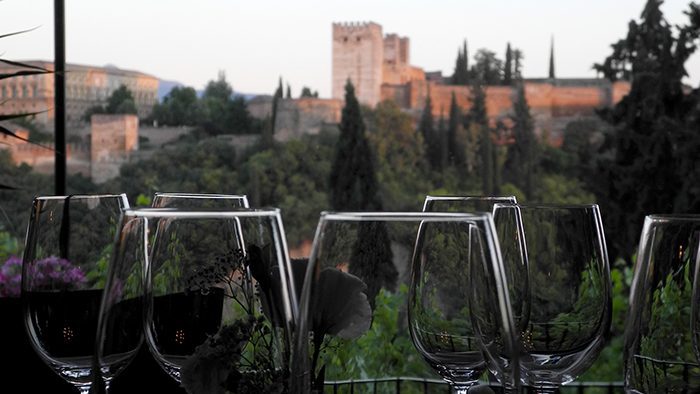
Named after the last Queen of the Nasrid Dynasty, this restaurant has it all! Once you step through the large wooden doors of this converted Carmen (typical Albayzin house) you will find yourself in paradise. Mirador de Morayma has the ultimate best view of the Alhambra and the food is spectacular. I suggest that you reserve a table for two outside in the botanical garden with the picturesque scenery of the Alhambra and the Sierra Nevada. The staff is professional, warm, and friendly. This was truly my favorite place I ate in Granada because of the quality of the food and the delightful candle-lit ambiance.

You may remember this place as a feature in a 2007 TV series on Spain hosted by American actress Gweneth Paltrow. Mirador de Morayma is a first class place with first class views of the enchanting city of Granada. The restaurant has seating for many inside (you would still have a view of the Alhambra) if you wish to come with a large group, and hosts Flamenco shows on Monday and Wednesday nights from 8:30 PM to 10:30 PM.

This is the type of place you dream of experiencing when travelling. Try the tasting menu for two so that you can try a variety of the restaurant’s famous dishes. It will run you 60 to 90 Euros per tasting menu.
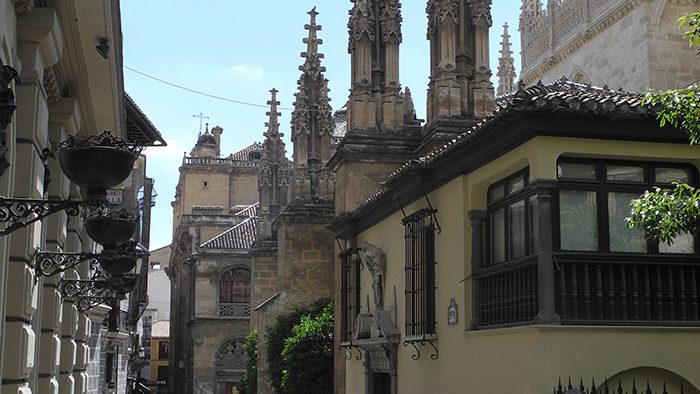
The monastery of St. Jerome was the first Catholic monastery established in Granada. The Catholic Monarchs commissioned it and construction began soon after the Arabs surrendered the city in 1496. In 1521 the monks of the order of St. Jerome moved into the monastery and there they served the church for the next three centuries. In 1835, however, the monastery was shut down as per the Law of Dissolution, which prohibited most religious orders. The building ultimately fell into disrepair and it was not until 1958 that a restoration project allowed for monks to move back in.
Check out 15 Things to See and Do in Cordoba, Spain

Presently, the monastery of St. Jerome is a cloister that is home to the Community of Sisters of St. Jerome. Inside, visitors will find a cheerful courtyard containing a garden of well-groomed orange trees. On the walls you will notice several coats of arms, which denote the founding monarchs’ crests. Walk along the inner walls and stroll through the different chapels and wings to get an idea of what Catholic monastic life was like in the 15th century.

Alcaiceria means House of Caesar, and the name of the street has existed since Emperor Justinian allowed the Moors permission to sell silk in this ancient Bazaar. Alcaiceria is not a very long street, but it was once part of an extensive market for buying and negotiating spices and silk. It was in Granada where the silk was woven and prepared for sale. The once-large bazaar was downsized due to a fire in 1843 that set much of it ablaze.

Today you will find that Alcaiceria Street is lined with tourist shops full of Grenadian and Spanish trinkets. I recommend not spending your money in these stores, but holding off for another, and just enjoying this antique narrow street that smells of burning incense. Take a stroll through Alcaiceria and you will feel as though you are in Morocco.
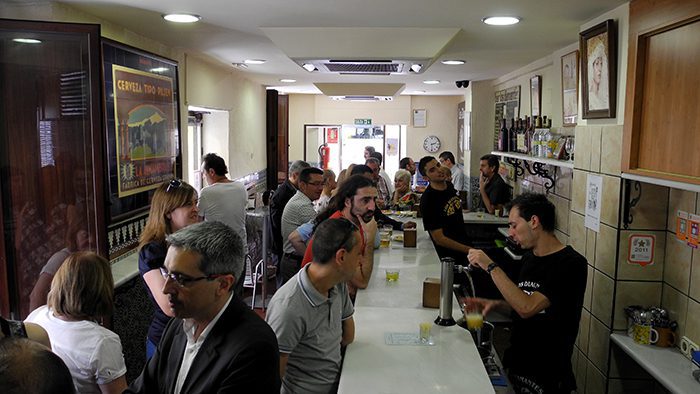
There are two locations of this popular and favorite of the locals. Los Diamantes and Los Diamantes II are great casual places to stop in to enjoy seafood on a budget. Los Diamantes is an informal restaurant where you can choose from a variety of treats from the sea fried to golden perfection. Both locals and tourists flock into these family-owned tiny restaurants for ice-cold beers and the tasty tapas.

It is typical to see patrons standing shoulder to shoulder at the counter waiting for their dishes to come out of the kitchen hot and fresh. The staff is friendly and moves at lightning speed as they chop, pour, mix, and fry everyone’s order. Just remember to squeeze lemon juice on it and you are ready to eat!
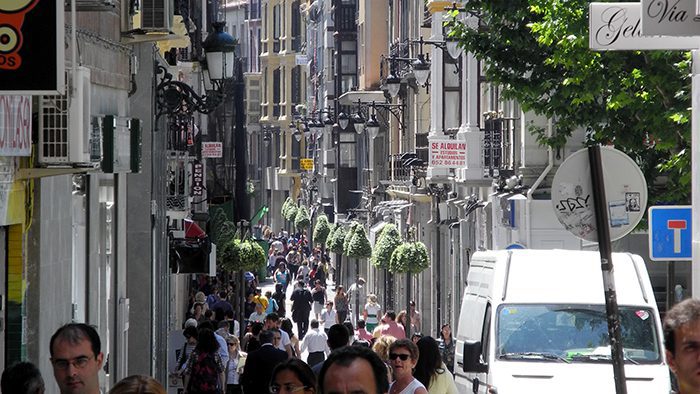 Gran Vía de Colón is the main street that runs through the center of Granada. If you are on Gran Vía, you are relatively close to most of the must see’s in town. Along Gran Vía you will find tourists and locals alike walking, lunching, shopping, and talking. It is pedestrian-friendly in both directions, and many of the mini buses can be caught on this main avenue. Gran Vía is a great place to shop or to stop into an ice cream shop for a refreshing mid-day snack. There is a famous bronze statue depicting Christopher Columbus standing in front of Queen Isabella. She, of course, commissioned his journey to the New World and their meeting is represented in public for all to see. Carrera del Darro is an old cobblestone street that runs parallel to the Darro River.
Gran Vía de Colón is the main street that runs through the center of Granada. If you are on Gran Vía, you are relatively close to most of the must see’s in town. Along Gran Vía you will find tourists and locals alike walking, lunching, shopping, and talking. It is pedestrian-friendly in both directions, and many of the mini buses can be caught on this main avenue. Gran Vía is a great place to shop or to stop into an ice cream shop for a refreshing mid-day snack. There is a famous bronze statue depicting Christopher Columbus standing in front of Queen Isabella. She, of course, commissioned his journey to the New World and their meeting is represented in public for all to see. Carrera del Darro is an old cobblestone street that runs parallel to the Darro River.
Check out Top Things to See in Leon, Spain

You can turn onto it soon after Gran Vía de Colón changes names to Calle Reyes Católicos. Carrera del Darro is an ideal place to stop and take in the charm of Granada’s Moorish and Renaissance roots. Old bridges over the Darro River are still being used today and make for great pictures. Be careful, however, because Carrera del Darro sometimes has traffic and there are no sidewalks along some of its sections. Walking along the stone wall is your best bet to make it down Carrera del Darro safely.
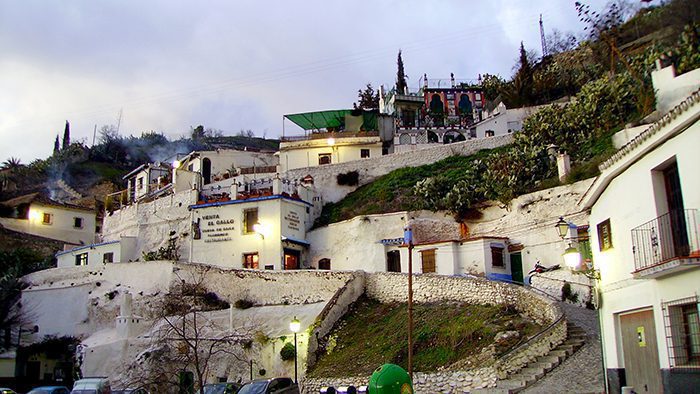
Sacromonte is a section of Granada that cannot be missed! If you are interested in Gypsy or Roma culture then you should make your way up to this neighborhood for some authentic Flamenco shows in the evening. From Sacromonte you can also enjoy great views of the Alhambra and the Darro River below. Camino del Sacromonte is the main street that runs through Sacromonte and it is lined with caves. These caves were where the Gypsies lived for hundreds of years as a way to preserve their culture, but now the caves house various restaurants and bars.

Be sure to ask your hotel concierge about which Flamenco or Zambra show you should see. I have heard of tourists being scammed with poor Flamenco performances, so it would be worth your time (and money) to ask. The Museum of Sacromonte is a great place to learn about the culture and history of the people who lived there. You can get there by taking Bus # 34 from Plaza Nueva to Sacromonte 2. The admission price to enter the museum is 5 Euros.

If you have any suggestions about the top things to do in Granada, Spain, leave a comment below!
Counter
101 Countries • 1432 Cities